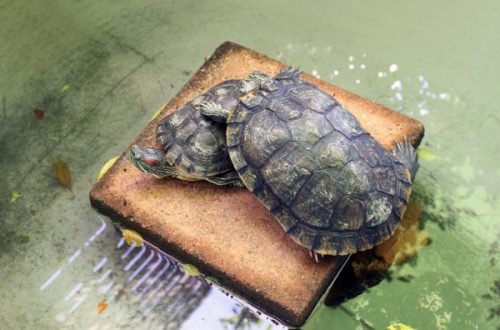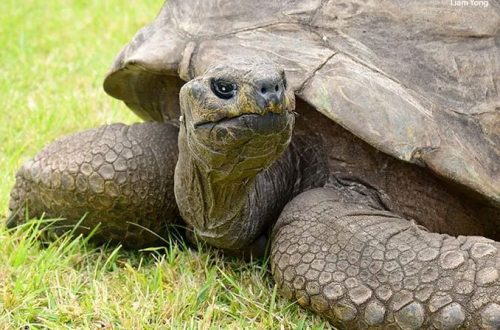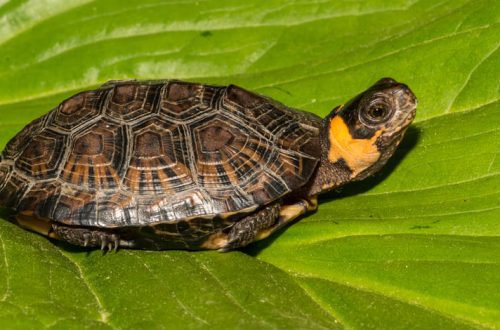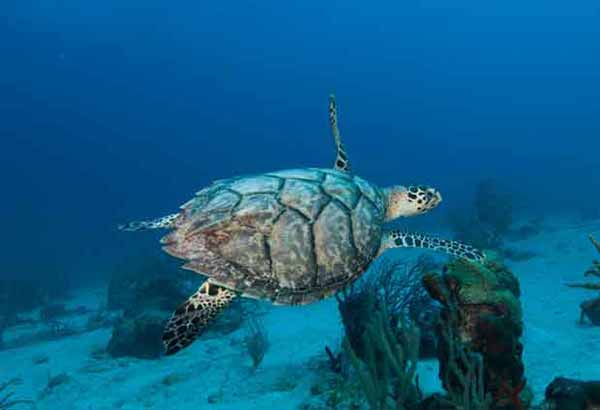
The habits and behavior of turtles
The actions of turtles are guided by instincts fixed by heredity. These instincts determine the animal’s response to stimuli such as climate, light, rainfall, and sensory impressions. The basic instincts are the instincts of reproduction and self-preservation. Self-preservation includes well-being, protection, flight, shelter from enemies, search for food. The reproductive instinct includes finding a mate, attracting a male, mating and laying eggs.
Thanks to coloration, low mobility, a secluded lifestyle, as well as the structure of the shell, turtles manage to hide or defend themselves from enemies.
However, despite their instincts, turtles are able to visually and by sound recognize those who feed them (memory of contacts), as well as develop certain behaviors in order to show something or achieve something from a person. Turtles can also become stressed and refuse to eat when new animals enter the apartment.
Different turtles, even within the same species, have different characters (sanguine, choleric, phlegmatic and melancholic), so do not be surprised that one turtle will hide in its shell if you pick it up, and the second will try to bite you and run away.
1. A land tortoise rises fully to its feet when water is poured on it.
Some land turtles (radiant, Galapagos) when water is poured on them, they rise to their full height on their paws and stretch their necks. It is believed that in this way they try to keep moisture on the shell.
“During the rain, the behavior of the radiant tortoise can be called strange, because they rise high on their large paws and sway up and down and to the sides. It seems that in this way they are trying to shake off the raindrops from themselves. These movements are called “rain dance.” Source


2. Turtles stretch their hind legs
some turtles, sitting on the shore and drying themselves, stretch their hind legs to their full length. This helps to dry the entire surface of the body and paws. Land tortoises stretch their legs, lay their heads on the ground, and close their eyes when sunbathing or resting. If the turtle is weakened and does not respond to you, then it is recommended to check its health.


3. Turtles inflate their throats
The turtle puffs out its throat. Turtles, like amphibians, are able to inflate their throats, but unlike the latter, they do this not when breathing, but for the purpose of smelling. In male red-footed tortoises (Chelonoidis carbonaria), swelling of the throat, along with head nodding and “croaking” sounds, has been noted when they try to attract the attention of a female. The skin is less tight around their throat than other turtles, so this is especially noticeable.
4. Turtles nod
Turtle head nodding is part of mating behavior. Males nod to females to also get a female’s attention when they want to mate with her. And the nodding of a male to another male shows that this territory belongs to him and he is ready for ritual battles for the female and territory. If the turtle lives alone, it can nod to its reflection in the mirror or glass of the terrarium, as it sees another turtle in front of it. Females can nod their heads to drive lymph.
5. Land turtles fight, ram each other
During the mating season or when fighting for territory, male tortoises begin to fight. During the fight, the opponents push each other and push “face to face”, or try to pry the opponent with the front shields, push them to the side or turn them over on their backs. For this purpose, the males of some species have special growths similar to spurs on the throat shields of the plastron. Trying to intimidate each other, the males walk in a circle and try to take a more advantageous position. When one jumps on the other, the second, with the help of certain movements, tries to turn the attacker over. In the presence of a female, the fight can last a very long time. Sometimes one of the males may retreat and move on. This behavior of males stimulates the interest of the female. Females can jump on males to show who is in charge in the territory as well as males. Often this happens when the female is pregnant and restricts her territory to lay eggs.

6. Aquatic turtle tickles another with its paws
Male red-eared turtles, when courting females, swim backwards in front of them and tickle their cheeks and necks with their long claws.

7. Turtle bites
A turtle may bite a person out of aggression (to protect itself) or mistaking his fingers for food.
A turtle may bite its paws when it is nervous, or if its limbs are itchy from a bacterial or fungal infection.
Turtles may bite each other for several reasons:
1. To drive a stranger from your territory, protect the laying place (when the female is about to lay her eggs, other turtles interfere with her).
2. As courtship: during mating, marsh turtles bite the neck of the female, and Central Asian males run around the female and bite her on the front paws so that she opens up and lets her mate with her. This leads to the fact that the female retracts her front paws and head, and the tail and hind legs begin to stick out from under the shell, which is in the hands of the male.
If there are very weak and sick individuals in a group of several turtles (land or water), then the stronger ones can gather and bite the weak individual to death, so it is important to separate the weak and sick turtles from the rest of the group of reptiles.
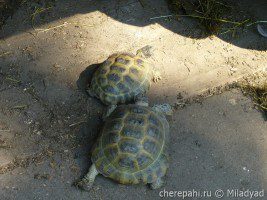

8. Turtle hisses
Turtles can hiss. Often, a hiss is heard when the turtle abruptly pulls its head into the shell. At the same time, the lungs are compressed and the air comes out with a hiss. Also, from turtles, you can hear clicking (when closing the mouth), snorting (most likely also due to putting the head into the shell), sneezing.
Turtles usually hiss in surprise or on purpose to show their displeasure. This is all the norm, and not a sign of illness, but squeaks and whistles (if this is not a mating male) may already be a sign of illness.
9. The turtle hides in the shell
If the turtle is frightened, it will hide in its shell, covering its head with its paws. However, some species of turtles can not only hide in the shell, but also completely close it. These turtles include box turtles, such as the Carolina box turtles. They can close the shell in front and behind due to the flexible jumper on the lower shell (plastron). Large-headed tortoises, when threatened, cannot hide their large heads in their shells, so they open their mouths threateningly.
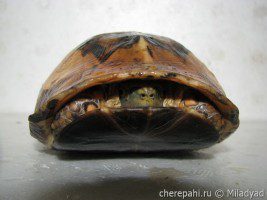
10. Turtle climbs on another and squeaks When mating, the males climb on the back of the females and begin to move quite quickly, while emitting something similar to “screams” or “squeaks”, which (they say) are unique in all species. Even if the male is in a mating position, it is enough for the female to take a few steps forward and the male will settle on the ground.

11. Aquatic turtle bites the neck of a female Male aquatic turtles do not usually bite females, but may bite slightly for stimulation. Immediately before mating and in the process, the male trembles and rubs his head against the female, fixes the female with his mouth and paws, and tucks his tail from below, bringing the cloacae closer together.
12. The turtle walks along the wall of the terrarium or paddock and tries to climb Most likely the turtle is dissatisfied with its living conditions. If the turtle has just moved into a new terrarium, then this behavior may mean that it is curious about the new territory. She will calm down in a day or two.
13. Turtle digs If your turtle is constantly digging in the ground, then it is possible that you have a female that wants to lay eggs. Females can also lay unfertilized eggs when there is no male nearby, or the male failed to fertilize them. In this case, it is necessary to provide the turtle with a place for laying, if it is an aquatic turtle (put a cuvette with sand or plant it in a container with sawdust, sand or coconut flakes).
14. The turtle closes in a shelter and stops eating. If this happens in late autumn or mid-summer in tortoises, then this means that the tortoise wants to go into winter or summer hibernation. Also, food refusal can be associated with magnetic storms, changes in weather and pressure. Keep an even temperature in the terrarium during the day (26-28) and at night (22-24) and soon the turtle will behave as usual. If an aquatic or terrestrial turtle behaves this way outside of the hibernation season and the animal is in its native terrarium and has not been stressed, then it is likely that it is sick.
15. The turtle lies on its back Most land and aquatic turtles can perfectly roll over from their back (carapace) to their stomach (plastron) on their own, pushing off with their head and paws. But adult sea turtles, being on their backs, cannot roll over and can die within a few hours from overheating. The position on the back for the turtle is uncomfortable, but not fatal and does not cause her pain. Large in size, and hence in age, turtles were especially difficult. The younger the turtle, the sooner it looks out of the shell to assess the situation, and the sooner it starts to move. The oldest reptiles (over 26 years old) sat motionless in the house for the longest time. Turtles with rounded shells turn over faster than their flatter counterparts.




